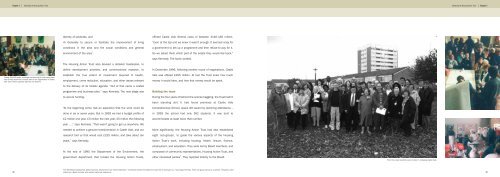cv-no-longer-notorious-book
cv-no-longer-notorious-book
cv-no-longer-notorious-book
Create successful ePaper yourself
Turn your PDF publications into a flip-book with our unique Google optimized e-Paper software.
Chapter 2 | Setting Up the Housing Action Trust Setting Up the Housing Action Trust | Chapter 2<br />
identity of landlords, and<br />
4) Generally to secure or facilitate the improvement of living<br />
conditions in the area and the social conditions and general<br />
environment of the area 2 .<br />
offered Castle Vale lifetime costs of between £140-160 million.<br />
“Even at the top end we knew it wasn’t e<strong>no</strong>ugh. It seemed crazy for<br />
a government to set up a programme and then refuse to pay for it.<br />
So we asked them which part of the estate they would like back,”<br />
says Kennedy. The tactic worked.<br />
The Housing Action Trust also devised a detailed masterplan, to<br />
During 1994/95 public meetings and planning for real events were<br />
held to help determine a master plan for the regeneration of Castle<br />
Vale (also shown opposite right top and bottom).<br />
define development priorities, and commissioned research, to<br />
establish the true extent of investment required in health,<br />
employment, crime reduction, education, and other issues relevant<br />
to the delivery of its holistic agenda. “Out of that came a costed<br />
programme and business plan,” says Kennedy. The next stage was<br />
to secure funding.<br />
“At the beginning some had an aspiration that the work could be<br />
done in six or seven years. But in 1993 we had a budget profile of<br />
£2 million one year, £3 million the next year, £5 million the following<br />
year …,” says Kennedy. “That wasn’t going to get us anywhere. We<br />
needed to achieve a genuine transformation in Castle Vale, and our<br />
research told us that would cost £225 million, and take about ten<br />
years,” says Kennedy.<br />
At the end of 1995 the Department of the Environment, the<br />
In December 1996, following a<strong>no</strong>ther round of negotiations, Castle<br />
Vale was offered £205 million. At last the Trust knew how much<br />
money it would have, and how that money would be spent.<br />
Building the team<br />
During the four years of behind-the-scenes haggling, the Trust hadn’t<br />
been standing still. It had found premises at Castle Vale<br />
Comprehensive School, space left vacant by declining attendance –<br />
in 1993 the school had only 362 students. It was built to<br />
accommodate at least twice that number.<br />
More significantly, the Housing Action Trust had also established<br />
eight ‘sub-groups’, to guide the various aspects of the Housing<br />
Action Trust’s work, including housing, health, leisure, finance,<br />
employment, and education. They were led by Board members, and<br />
composed of community representatives, Housing Action Trust, and<br />
government department that funded the Housing Action Trusts,<br />
other interested parties 3 . They reported directly to the Board.<br />
From the outset residents were involved in reshaping Castle Vale.<br />
18<br />
2<br />
The HAT Board subsequently added eco<strong>no</strong>mic develoment to its internal objectives. “Our Board wanted the additional scope that it would give us,” says Angus Kennedy. 3 Each sub-group had up to six places. The groups were<br />
chaired by a Board member with relevant skills and experience.<br />
19


